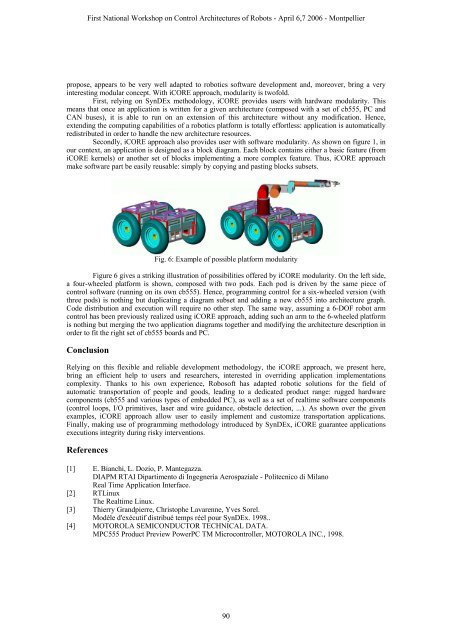Pleading for open modular architectures - Lirmm
Pleading for open modular architectures - Lirmm
Pleading for open modular architectures - Lirmm
You also want an ePaper? Increase the reach of your titles
YUMPU automatically turns print PDFs into web optimized ePapers that Google loves.
First National Workshop on Control Architectures of Robots - April 6,7 2006 - Montpellier<br />
propose, appears to be very well adapted to robotics software development and, moreover, bring a very<br />
interesting <strong>modular</strong> concept. With iCORE approach, <strong>modular</strong>ity is twofold.<br />
First, relying on SynDEx methodology, iCORE provides users with hardware <strong>modular</strong>ity. This<br />
means that once an application is written <strong>for</strong> a given architecture (composed with a set of cb555, PC and<br />
CAN buses), it is able to run on an extension of this architecture without any modification. Hence,<br />
extending the computing capabilities of a robotics plat<strong>for</strong>m is totally ef<strong>for</strong>tless: application is automatically<br />
redistributed in order to handle the new architecture resources.<br />
Secondly, iCORE approach also provides user with software <strong>modular</strong>ity. As shown on figure 1, in<br />
our context, an application is designed as a block diagram. Each block contains either a basic feature (from<br />
iCORE kernels) or another set of blocks implementing a more complex feature. Thus, iCORE approach<br />
make software part be easily reusable: simply by copying and pasting blocks subsets.<br />
Fig. 6: Example of possible plat<strong>for</strong>m <strong>modular</strong>ity<br />
Figure 6 gives a striking illustration of possibilities offered by iCORE <strong>modular</strong>ity. On the left side,<br />
a four-wheeled plat<strong>for</strong>m is shown, composed with two pods. Each pod is driven by the same piece of<br />
control software (running on its own cb555). Hence, programming control <strong>for</strong> a six-wheeled version (with<br />
three pods) is nothing but duplicating a diagram subset and adding a new cb555 into architecture graph.<br />
Code distribution and execution will require no other step. The same way, assuming a 6-DOF robot arm<br />
control has been previously realized using iCORE approach, adding such an arm to the 6-wheeled plat<strong>for</strong>m<br />
is nothing but merging the two application diagrams together and modifying the architecture description in<br />
order to fit the right set of cb555 boards and PC.<br />
Conclusion<br />
Relying on this flexible and reliable development methodology, the iCORE approach, we present here,<br />
bring an efficient help to users and researchers, interested in overriding application implementations<br />
complexity. Thanks to his own experience, Robosoft has adapted robotic solutions <strong>for</strong> the field of<br />
automatic transportation of people and goods, leading to a dedicated product range: rugged hardware<br />
components (cb555 and various types of embedded PC), as well as a set of realtime software components<br />
(control loops, I/O primitives, laser and wire guidance, obstacle detection, ...). As shown over the given<br />
examples, iCORE approach allow user to easily implement and customize transportation applications.<br />
Finally, making use of programming methodology introduced by SynDEx, iCORE guarantee applications<br />
executions integrity during risky interventions.<br />
References<br />
[1] E. Bianchi, L. Dozio, P. Mantegazza.<br />
DIAPM RTAI Dipartimento di Ingegneria Aerospaziale - Politecnico di Milano<br />
Real Time Application Interface.<br />
[2] RTLinux<br />
The Realtime Linux.<br />
[3] Thierry Grandpierre, Christophe Lavarenne, Yves Sorel.<br />
Modèle d'exécutif distribué temps réel pour SynDEx. 1998..<br />
[4] MOTOROLA SEMICONDUCTOR TECHNICAL DATA.<br />
MPC555 Product Preview PowerPC TM Microcontroller, MOTOROLA INC., 1998.<br />
90

















